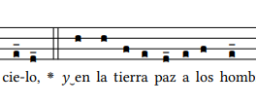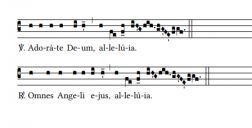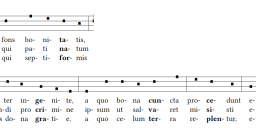Instant chant engraving with Gregorio
-
To my great surprise, when I went to find an example, I discovered that this function now works again - many thanks, and apologies!
-
Dear Chonak, thank you soooooo much for this treasure ! I discovered it about 5 months ago, and I started coding some scores (mozzarabic lamentationes, lectiones...). I even mixed gregorian with some Finale modern notation scores, that is very useful for my little french choir, to sing for instance Popule Meus by Victoria with the gregorian Reproaches.
I have a question : is it possible to modify the margins (a balance between crop margins and the default ones) ? I tried on Adobe pro but it seems to be impossible...
I now that it is possible on Gregorio, but after having tried for 1 month I didn't manage to produce anything good, i'm not good enough in English and informatic.
Any help would be great ! -
There isn't an option to adjust the margins on the site at gregoiochant.org. You can change the paper size and get a PDF that is, for example, 6"x9". It would be possible then to print that on conventional letter-sized paper.
The other web site for running Gregorio has a feature for adjusting the width of the score, so you can try that:
http://apps.illuminarepublications.com/gregorio/
-
Ousier,
you mentioned en passant that you've done up a mixed Victoria/chant version of the Popule Meus. Have you made that available on the web? I'd very much appreciate a copy, as we've sung a mixed version for the last few years, and I decided on Good Friday this year that it would be good to have it all set out, to eliminate the trouble of going between Victoria and the chant. Happy Easter! -
Hello.
i need help how to create grego sheet by gabc natation and TexLive. i'm already instal and following instruction form both software, but nothing happen displaying my sheet.
can someone help me?
(ps: using illuminare need constant internet connection)
PM me.
thank you very much
-
You can use my web interface for gregorio without a constant internet connection:
http://run.gregoriochant.org/
(this URL replaces the former site name at gabrielmass.com)
You can edit your GABC text file on your PC before you connect; then connect, use the web site, save the PDF output, and then disconnect.
This will be easier than installing the software at home. Learning TeX is a lot of work, and I do not encourage beginners to bother with it. -
Here, incidentally, is a free online course for learning LaTeX, when you get to the point of needing it: e.g., for typesetting articles or books:
https://www.overleaf.com/latex/learn/free-online-introduction-to-latex-part-1 -
all.
i did it using TexLive and gregorio.
it's work!! Finally!! -
Hugh,
I'm sooooo sorry for the delay ! I just saw today your answer...
Here is my edition of Popule Meus. It's not complete, because I don't sing it entirely, we're not that much in my parish and i can't skip Crux Fidelis !

 Popule meus + grégorien 2 - Victoria.pdf243KThanked by 1andreasadi
Popule meus + grégorien 2 - Victoria.pdf243KThanked by 1andreasadi -
A little update to the online Gregorio processor: it now supports the undertie character ( ‿ ) , which is helpful for representing vowel elisions in Spanish.
Here is a GABC example:
name:Gloria (Misa VIII);
%%
(c3)GLO(h)ria‿{a}(fe) Dios(d) en(e) el(f) cie(e_)lo,(d_) \greheightstar(::) y‿{e}n(h) la(h) tie(f)rra(e) paz(d_) a(e) los(f) hom(e_)bres(d_) (,) que(d) a(d)ma(e) {e}l(f) Se(h)ñor.(ih..)
and the site address is
http://run.gregoriochant.org/
Output looks like this:
As usual, let me know if anything about it doesn't seem to be working.
 gloria.png643 x 104 - 21K
gloria.png643 x 104 - 21K -
I am trying to open a GABC PDF file in illustrator to layout organ modern notation with GC notation above it. I cannot find the correct chant notation font in order to open the PDF so that it renders correctly. I downloaded fonts I found on the internet that I believe are Tex fonts. Are these the right ones? I am on a mac using Adobe CC.
greciliae-hole.ttf
greciliae-hollow.ttf
greciliae-op-hole.ttf
greciliae-op-hollow.ttf
greciliae-op.ttf
greextra.ttf
gregall.ttf
grelaon.ttf
gresgmodern.ttf -
Hi All (and Richard especially) :)
I am using the Illuminare editor and want to reduce space between some of the words and syllables so that my lines fit neatly to the prescribed length. Is there a way to accomplish this? In typography it is called kerning. Would love to be able to do this in the gabc tool. Thanks. -
francis - if you will excuse my correction, what you want to achieve is called tracking - changing the general spacing between letters (kerning is between particular pairs of letters, such as AW). I mention this in case it makes it easier to find any reference on how to do it.Thanked by 1francis
-
The on-line system at run.gregoriochant.org has a more recent edition of the Gregorio software than is at Illuminare, so you might try running your code there to see if the result might happen to produce more favorable spacing.
There are many adjustable parameters in the GregorioTeX system that regulate the placement of objects, so it is conceivable that the spacing between words might be adjustable.
To do customized use of Gregorio, you should install a copy of the TeXLive software edition on your PC; that will include the latest version of Gregorio. You'll need to learn to write document files for the LaTeX document processing system, and also use the available GregorioTeX macros to set the parameters you want to work with. If you're new to LaTeX, you can start with https://www.latex-tutorial.com/tutorials/ . The GregorioTeX macros are documented in this https://github.com/gregorio-project/gregorio/releases/download/v5.2.1/GregorioRef.pdf . It's 305 pages.Thanked by 1francis -
Hello, Richard. It's been a while since I used Gregorio so I don't know if some codes have been changed. I have successfully created notation for a Versicle and Response, however with two mysteries left unsolved. 1. After some unacceptable versions, I ended up with the desired two staves instead of the Response continuing on the same staff until it was out of room and finished on a second staff. I don't know how this happened, but I'm glad that's taken care of. 2. I'm trying to get the V-slash and R-slash using the code Summary and it just ain't happening. I have for example, V/ for the Versicle on my code sheet. I've tried putting it in different places in the code. Annotation got it to a good place by the score but did output the V-slash that is customary for the Versicle. Much obliged for your attention.
-
The V/ and R/ have to be wrapped in an "sp" . . . "/sp" tag, like this:
%%
(c3)<sp>V/</sp>. {A}(h)do(h)rá(h)te(h) De(hi)um,(h_') (,)
al(h)le(fe)lú(f_h)ia.(hiH'Ghih.ghG'FE'fggf.) (::Z)
<sp>R/</sp>. {O}m(h)nes(h) An(h)ge(h)li(h) e(hi)jus,(h_') (,)
al(h)le(fe)lú(f_h)ia.(hiH'Ghih.ghG'FE'fggf.) (::)
The initial-style setting was 0 (zero) for this example.
 Screenshot_20200727_202207.png448 x 228 - 13KThanked by 1CHGiffen
Screenshot_20200727_202207.png448 x 228 - 13KThanked by 1CHGiffen -
It's been on-line for ten years!
-
Wow! has it been that long???
-
It's what got me started, in 2011, until my Dad saw what I was doing and installed TeX.
I am still pottering away on and off, and hope eventually to have a book to show for it. -
so i was trying to engrave a piece i composed (in English) using the Source and Summit score editor for GABC and cannot figure out how to move the te sign (flat) and natural sign to a specific line or space. Does anyone know how to do this? also, i cannot get the sharp sign to show up... do you put the # sign before the note name? [e.g., #sharp(i)]
-
Just messing around (with Latin, but the same principles apply).
%%
(c4) Gau(c)de(d)a(ixdh'i)mus(h.) (,) mus(d#)
You need to move theix(oriyfor the natural) around accordingly, and sometimes you just have to play with it.#goes after the letter.Thanked by 1francis -
Apologies if this has already been answered. Do any of the online GABC editors allow for multiple verses under a single line of neumes yet, and if they do, where can I go to learn how to write the input for this purpose?Thanked by 1Bri
-
@francis
I think you mean the vertical positioning? The x is the flat sign and the letter before the x is the pitch it's on. So ix is the flat sign in the top space. etc. gx would be the flat sign in the space below that.
@liampmcdonough
A great question and very useful. It's a little too complicated to be done within Gregorio and can only be done in LaTeX, not really in the online editors. There is a reasonably readable tutorial at the Gregorio Project that goes part of the way to sorting it out. I have recently spent a good deal of time working on this sort of thing, as you can see in the attached file. If you want to send me your specific project details as a direct message, I might be able to help you.

 kyrie.png1346 x 460 - 82KThanked by 1francis
kyrie.png1346 x 460 - 82KThanked by 1francis -
@liampmcdonough what you describe is very easy with Benjamin Bloomfield's GABC Transcription Tool. Select the checkbox labelled "All verses to one line of chant".
The page opens with Adoro Te as an example. The (About) page has more details. -
Thanked by 1GerardH
-
Ok, thank you! Help me out again. I can paste my code into the integrated GABC input, see below. When I click the all verses option it just garbles everything. Is this a glitch, or do I need to fix my input in some way?
name: Untitled Document;
supertitle: ;
title: Ave, Mary, Full of Grace;
subtitle: ;
text-left: Ave Plena Gratia, Sequence for Purification B.V.M., trans. W.J. Copland (1804-1885);
text-right: Presentation, Liam McDonough (b. 1993);
annotation: HYMN;
%%
A(c)ve(d), Ma(e)ry,(f) full(d) of(d) grace,(c.) (,)
In(e) whose(f) Vir(gh)gin(g) arms'(fe) em(f)brace(g.) (,)
God(h) to(i) God(j) Him(i)self(h) doth(h) vow!(g.) (:)
We(j) would(i) at(h) the(j) Tem(i)ple(h) wait,(g.) (,)
We(h) would(g) meet(fe) Thee(f) at(gf) the(e) gate,(d.) (,)
Je(c)su,(d) for(e) our(f) all(d) art(d) Thou.(c.) 2.(::)
God(c) is(d) to(e) His(f) Tem(d)ple(d) come;(c.) (,)
An(e)gels(f) throng(gh) the(g) hal(fe)low'd(f) dome;(g.) (,)
What(h) be(i)yond(j) hath(i) Heav'n(h) in(h) store?(g.) (:)
God(j) Him(i)self(h) our(j) flesh(i) doth(h) wear;(g.) (,)
Owns(h) a(g) Vir(fe)gin(f)-Mo(gf)ther's(e) care;(d.) (,)
This(c) than(d) Heav'n(e) it(f)self(d) is(d) more! (c.) 3.(::)
In(c)cense(d)-gales(e) of(f) glad(d)ness(d) rise,(c.) (,)
At(e) this(f) morn(gh)ing's(g) Sa(fe)cri(f)fice; (g.) (,)
Hymns(h) through(i) all(j) the(i) Tem(h)ple(h) sound;(g.) (:)
Eve(j)ning's(i) rite(h) in(j) tears(i) shall(h) end,(g.) (,)
And(h) with(g) bit(fe)ter(f) weep(gf)ings(e) blend,(d.) (,)
As(c) they(d) stand(e) the(f) Cross(d) a(d)round.(c.) 4.(::)
Here(c) the(d) Sa(e)cri(f)fice(d) is(d) brought,(c.) (,)
By(e) Whose(f) price(gh)less(g) val(fe)ue(f) bought,(g.) (,)
We(h) are(i) all(j) to(i) God(h) made(h) nigh;(g.) (:)
We(j) no(i) lon(h)ger(j) are(i) our(h) own,(g.) (,)
Thine,(h) O(g) God,(fe) we(f) are(gf) a(e)lone!(d.) (,)
Thine(c) we(d) live,(e) and(f) Thine(d) we(d) die.(c.) 5.(::)
Let(c) Thy(d) ser(e)vants(f) now(d) de(d)part;(c.) (,)
Let(e) us(f) see(gh) Thee(g) as(fe) Thou(f) art,(g.) (,)
Naught(h) of(i) earth(j) ar(i)rest(h) our(h) eyes:(g.) (:)
But,(j) if(i) here(h) we(j) stay(i) be(h)low,(g.) (,)
In(h) Thee,(g) Je(fe)su,(f) let(gf) us(e) grow,(d.) (,)
So(c) in(d) Thee(e) we(f) shall(d) a(d)rise.(c.) (::)
A(cdc)men.(b.c.) (::) -
Much easier to have the text and the tune separated. But while playing around I have lost it and it's bed time here.
Integrated gabc would look like this :-
initial-style: 1;
centering-scheme: english;
%%
A|2. God |3. In|4. Here |5. Let (c)ve,|is |cense- |the |Thy (d) Mar|to |gales |Sac|ser(e)y,|His |of |ri|vants (f) full|Tem|glad|fice |now (d) of|ple |ness |is |de(d) grace,|come; |rise, |brought, |part; (c.) (,)
In|An|At |By |Let (e) whose|gels |this |Whose |us (f) Vir|throng |morn- |price|see (gh)gin|the |ing's |less |Thee (g) arms'|hallow'd |Sac|val|as (fe) em|dome; |ri|ue |Thou (f)brace|What |fice; |bought, |art, (g.) (,)
God|be|Hymns |We |Naught (h) to|yond |through |are |of (i) God|hath |all |all |earth (j) Him|Heav|the |to |ar(i)self|'n |Tem|God |rest (h) doth|in |ple |made |our (h) vow!|store? |sound; |nigh; |eyes: (g.) (:)
We|God |Eve- |We |But, (j) would|Him|ning's |no |if (i) at|self |rite |long|here (h) the|our |in |er |we (j) Tem|flesh |tears |are |stay (i)ple|doth |shall |our |be(h) wait,|wear; |end, |own, |low, (g.) (,)
We|Owns |And |Thine, |In (h) would|a |with |O |Thee, (g) meet|Vir|bit|God, |Je(fe) Thee|gin- |ter |we |su, (f) at|Mother's |weep|are |let (gf) the|care; |ings |a|us (e) gate,|This |blend, |lone! |grow, (d.) (,)
Je|than |As |Thine |So (c)su,|Heav|they |we |in (d) for|'n |stand |live, |Thee (e) our|it|the |and |we (f) all|self |Cross |Thine |shall (d) art|is |a|we |a(d) Thou.|more! |round. |die. |rise. (c.) (::)
A(cdc)men.(b.c.) (::)
and I needed to sort out the syllabification of 'morning' and 'evening'
-
Yep, start with text and tune separately, then only switch to integrated when you're happy with the results.
I usually then paste the integrated gabc into the Source & Summit editor, which I prefer to use for the greater control over graphic output. -
Relevant quotation from the aforementioned (About) page:Will it work in reverse?
Yes, to some extent, although it isn't always working quite right at the moment. If you click 'Show integrated GABC' and type into the single textbox that shows up, it will separate the text from the GABC notation if you type or paste regular GABC with the text and GABC interleaved with parentheses, and display it as chant below. -
Unfortunately, although this method produces very nice multi-line scores in the GABC Transcription tool, and Source & Summit, I have not been able to get it to work at all in LaTex. When I put the GABC into a file for LaTex to use, or use \gabcsnippet, it just produces a score like the following. Is there something I'm doing wrong, or is this feature just incompatible with LaTex?

 test2.pdf22KThanked by 1GerardH
test2.pdf22KThanked by 1GerardH -
@OMagnumMysterium
That feature isn't built into Gregorio (yet!). The solution in LaTeX that you can find at the Gregorio Project, which I've also adapted successfully for some big projects, involves creating tab stops within the gabc file and then using the tabbing environment in the tex file to align the text of the subsequent verses. Then you can adjust horizontal alignment using\hspace.Thanked by 1OMagnumMysterium -
Thank you! This is a huge help.
Is there a way to change the alignment of the neums to the syllables so verses vertically align better, or is that beyond the capabilities of the program?
-
Is there a way to change the alignment of the neums to the syllables so verses vertically align better
Enclosing a character or group thereof in curly brackets will align that group to the first note of the neume. It's fidgety, and not always the result you're after. Try the below two variations of the code for example.
(c4)A |2{.}|3{.}|4{.}|5{.}()- | God | In| Here | Let (c)ve,|is |cense- |the |Thy (d) Mar|to |gales |Sac|ser(e)y,|His |of |ri|vants (f) full|Tem|glad|fice |now (d) of|ple |ness |is |de(d) grace,|come; |rise, |brought, |part; (c.) (,)
(c4)A|2.{ }God |3.{ }In|4.{ }Here |5.{ }Let (c)ve,|is |cense- |the |Thy (d) Mar|to |gales |Sac|ser(e)y,|His |of |ri|vants (f) full|Tem|glad|fice |now (d) of|ple |ness |is |de(d) grace,|come; |rise, |brought, |part; (c.) (,)
Welcome to the MusicaSacra Forum!
To participate in the discussions on Catholic church music, sign in or register as a forum member, The forum is a project of the Church Music Association of America.
Categories
- All Discussions21,157
- General Music Discussion8,236
- Job Openings204
- Management of Music Programs850
- Choral Matters533
- Church Documents and Rubrics526
- CMAA Notes303
- Events720
- For Newcomers: Read First26
- Sacred Polyphony547
- Hymnody872
- Gregorian Chant: General2,702
- ↳ Graduale Romanum and Liber Usualis368
- ↳ Graduale Simplex60
- ↳ Semiology63
- Vernacular Plainsong696
- Anglican Use and Anglican Chant68
- Organ, Other Instruments and Repertoire435
- New Composition/Works in Progress1,295
- Recordings234
- Music for Hispanic Ministry159
- Music Education: Children211
- Music Education: General222
- News Items245
- Positions Wanted2
- General Discussion: Catholicism740
- Amusements177
- General Discussion1,035
- Opinions119



